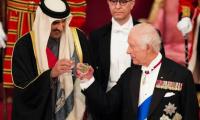The past three days US and China negotiators have met in Beijing to try one last time before a true trade war erupts between them in March 2019. Higher level trade negotiators will follow up in Washington in coming weeks.
What follows is the first of a 2-part history and analysis of Trump trade strategy, which addresses events from the initiation of Trump’s trade offensives in March 2018 to December 2018, with predictions for 2019. In part 1, US trade policy under Trump in 2018 is compared with similar US trade offensives under Nixon in the 1970s, targeting Europe, and Reagan in the 1980s targeting Japan. The historical parallels situate US trade policy as an important, often over-looked element in the evolution of US Neoliberalism.
“Trade War! Trade War! When Trump pre-announced on March 2 his plan to impose tariffs on steel and aluminum imports, the mainstream press immediately began hyping the line that trade war was looming on the horizon. Panicking, investors ran like lemmings over the stock market cliff after the steel tariff announcement; US allies huffed and puffed, promising tit-for-tat tariff responses on US agricultural goods or commercial aircraft; Trump’s traditional elite advisors, like Gary Cohn, former CEO of Goldman Sachs investment bank and head of Trump’s economic council, resigned later that week – no doubt in part due to frustration and disagreement over Trump’s unilaterally announced tariff.
At week’s end, on March 8, 2018, Trump proposed to implement steel and aluminum tariffs universally, across the board, affecting all importers to the US.: 25% tariffs on steel imports and 10% on Aluminum. The big 5 US steel importers are Canada, Mexico, South Korea, Brazil, and Germany–collectively responsible for $15 billion a year in steel imports. Canada, Russia and the United Arab Emirates are the major aluminum importers. (Worth noting, for 2017 steel imports China is well down the pack, tenth or eleventh on the list, contributing only 2.2% of US steel, importing in the millions of dollars annually – not billion – and mostly semi-finished steel goods used by US manufacturers for fabricating final goods produced in the US.) When announced on March 8, Trump argued there would be no countries exempted from the 25% tariffs on steel and 10% on aluminum. That quickly changed.
By mid-March, Canada and Mexico were temporarily exempted from the tariffs, even though they were among the top four largest steel importers to the US, with Canada largest and Mexico fourth largest. Thereafter, Brazil (second largest steel importer), Germany, and others steel importers were exempted. And Canada, by far the largest aluminum importer to the US, accounting for 43% of US aluminum imports, was exempted as well.
South Korea, the third largest steel importer last year, was exempted from steel tariffs permanently, as it quickly renegotiated its 2012 free trade deal with the US. Moreover, no other significant tariffs were imposed on South Korea as part of the bilateral treaty revisions. What the US got in the quickly renegotiated US-South Korea free trade deal, was more access for US auto makers into Korea’s auto markets. And quotas on Korean truck imports into the US.
Korean auto companies, Kia and Hyundai, had already made significant inroads to the US auto market. US auto makers have become dependent on US truck sales to stay afloat; they didn’t want Korean to challenge them in the truck market as well. Except for these auto agreements, there were no major tariffs or other obstructions to South Korea imports to the US. Not surprising, the South Koreans were ecstatic they got off so easily in the negotiations. Clearly, the US-South Korea deal had nothing to do with Steel or Aluminum. If anything, it was a token adjustment of US-Korea auto trade and little more.
So if the Korean deal was a ‘big nothing’ trade renegotiation, and if virtually all the US major steel and aluminum importers have been exempted worldwide, what’s Trump’s new trade policy aggression all about? US steel and aluminum imports combined make up only $47 billion – a fraction of total US imports of $2.36 trillion in 2017.
Was the steel-aluminum tariffs announcement just another example of Trump bombast, launched via tweets from the second story of the White House at 3am, to be followed by a quick retreat? Was the South Korean agreement a template and a big ‘softball’ for later negotiations with US trade allies – Mexico, Canada, Europe? Was it Trump shooting off his mouth and then retreating following pressure from his advisors and US business interests? Was the tariff announcement a ‘stalking horse’ for something bigger? Perhaps the tariffs were a cover for domestic political objectives – aimed either at agitating and mobilizing Trump’s political base in ‘red state’ America in preparation for midterm US elections in November 2018 or even a Trump decision to fire special investigator counsel Mueller in coming weeks? Playing the ‘economic nationalist’ card and mobilizing his base, by initiating new tariffs and talking of a ‘trade war’, would serve both Trump domestic political objectives.
For polls show Trump’s steel-aluminum tariffs announcement played well in the Midwest, the great plains states and the South; and especially in those steel and mining towns of Michigan, Ohio, West Virginia, Pennsylvania, Minnesota – i.e. those key swing states that gave him the narrow margin of victory in the 2016 elections! Even if he quickly shelved the tariffs, the media hype sent the message Trump wanted to his base: he was doing something about the decades-long loss of steel and mining jobs in those regions since the 1980s. In short, how much of the steel-aluminum tariffs were for domestic political consumption and how much not?
That question applies as well to the subsequent trade actions by the Trump administration. By the end of March, given all the exemptions, it became clear the real target of Trump’s trade offensive was China and not the rest of US allies.
A closer look at Trump administration statements since March 2018 reveals that Trump’s anti-China trade offensive has had less to do with China general imports to the US and more about US next generation technology transfer by US corporations to China. Next gen technologies like Artificial Intelligence (AI), G5 wireless networks, and similar cyber-security and militarily strategic tech now in development.
As Trump’s new chair of his Economic Council, Larry Kudlow, put it in March, “There’s no trade war. All we’re trying to do is protect US technology”. Kudlow added a month later, in early April, “Sometimes you have to use tariffs to bring countries to their senses”. Tariffs are the tactic, not the strategic policy objective. And if trade deficits are not the primiary issue, and tariffs are only the tactic, then what is the strategic objective? It’s technology transfer and domestic politics. Perhaps the US defense sector, in particular the NSA and Trump’s military generals-heavy administration, are playing a greater role in the US-China trade war in the background than is thus far noted by the media. And not enough attention is being given to the role of domestic political events as well.
Put another way, at the level of appearance, the US trade deficit and China imports to the US may be the target for purposes of public opinion. But behind the appearance, it’s more likely that US domestic politics plus US long term military planning are the two more important drivers behind Trump’s emerging trade war. All of Trump’s tariffs and subsequent trade measures are being invoked based on an obscure ‘national security’ clause in US trade legislation. And China is increasingly the target, as tariffs and other measures are suspended and reduced for US trading partners – with the exception of China – as the US pursues a soft trade ‘offensive’ against all its other trading partners.
This article has been excerpted from: ‘Trump’s Deja Vu China Trade War’.
Courtesy: Counterpunch.org.
Political instability has long plagued Pakistan, disrupting governance and economic planning
He was prolific writer and always expressed his views with clarity and firmness
In recent weeks, banks have searched for new borrowers, willing to take fresh debt at below-market rates
Pakistan’s constitution guarantees right to peaceful assembly – a cornerstone of democracy
Developing National WASH Account in Pakistan relies on range of stakeholders at federal, provincial, and district levels
Beauty of arbitration is that no conflicted party needs to sit at negotiating table and enter into dialogue with other...







